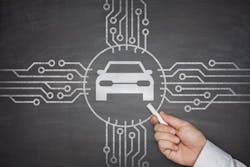J.D. Power’s 2017 Vehicle Dependability Study released in February, and it reflects another major improvement on vehicle dependability, which improved 9 percent over 2017—the first time the industry score has improved since 2013.
The study, now in its 29th year, measures the number of problems experienced per 100 vehicles (PP100) during the past 12 months by original owners of 2015 model year vehicles. Lower scores reflect higher quality, and the study covers 117 specific problems grouped into eight major vehicle categories. The overall industry averaged improved to 142 PP100, down from 156 PP100 in 2017.
A big part of the improvement, J.D. Power senior product manager David Amodeo says, is the advancement of in-vehicle technology, and the increased knowledge customers have about in-vehicle technology systems. However, technology is constantly improving and updating in vehicles, meaning drivers will crave to understand how their supercomputers-on-wheels work—which is where your shop comes into the picture.
Amodeo spoke with Ratchet+Wrench about the study, the main drivers behind the improvements in vehicle dependability, and how you can educate customers on vehicle technology that still leaves drivers frustrated.
This was the first time the industry score has improved since 2013, and vehicle dependability went up 9 percent. Were you expecting that drastic of an increase?
I was guessing for an improvement; I probably wouldn’t have pegged it for quite that number, though. We had improvements across the board with every category, some more than others. Everything is just getting better.
In general, more and more tech is getting introduced into the vehicles. This can be things like voice recognition, Bluetooth, or fuel-saving technology. Customers may struggle in the beginning with it, and struggle over time. Usually what happens, though, is things start leveling out as people become more used to the features on the vehicle, figure out how to use it, or just stop using it altogether. And with Bluetooth and voice recognition, the technology is advancing and the manufacturers are improving these systems.
It’s early, but do you expect the improvements to continue?
The overall industry improvement, yes. Over the last 25 years or so, the long-term trend is definitely improving quality.
We’re not exactly sure what tech will improve things on a more micro level. Ten years ago, nobody would have even thought about Bluetooth or voice recognition being a major issue. It’s entirely possible that something introduced today, like a driver safety system, or adaptive cruise control, might bubble up and affect things. Something could be introduced where we go through that same learning curve.
The average is still 142 PP100, which seems really high. Where are most of those issues found?
Most of them are in the audio communication, entertainment section. Things that you would expect, because of the interaction you have with them on a daily basis. With things like your car seat, you sort of set it and forget it. Instead of the fabric ripping or something major happening, it’s just there, and it won’t have any additional issues. With the communication systems, and the center stack, you’re using them multiple times per drive.
There’s this struggle that the manufacturers have because they’re building things for reliability. These things need to work on a car for 10 years. They need to be subjective to the heat, cold and all those sorts of things. Manufacturers have gotten a lot better with it over the years, but they still struggle with keeping the tech in the car being as good as what you can get elsewhere.
Is there any way that an automotive repair shop can capitalize on some of the issues that remain, especially in-vehicle tech?
A large part of this is communication is teaching people, and learning how these systems work. A customer who buys a new car may not want all this information at once, because they’re in the dealership for way longer than you want to be, and want to get out. You don’t necessarily get an explanation of other features. Maybe they’ll pair your phone for you or teach you some other things, but you may not be paying attention, then you’re gone and you wonder how to learn about these things.
You hope that manufacturers design things in a way that are super easy to use, but still, there are hidden features in there. Educating the customer for something like that, to make sure it isn’t a big worry can be beneficial, and create loyalty.

